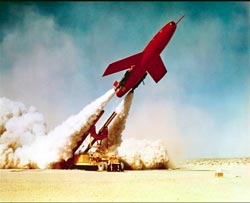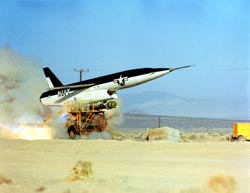|
 Design of the Regulus I guided missile started in the late 1940ís, and flight testing began in 1950. The Regulus I missile was powered by a turbojet engine and cruised at subsonic speeds, going supersonic in its terminal dive to a target. It had a 500-nautical-mile range and was designed to be launched from offshore submarines and cruisers and to carry a nuclear warhead to inland targets. Many of the Regulus I missiles had landing gear and parabrakes so that they could be recovered after test and training flights. Over 500 Regulus I missiles were produced, and submarines carrying Regulus I missiles were deployed through 1964. Design of the Regulus I guided missile started in the late 1940ís, and flight testing began in 1950. The Regulus I missile was powered by a turbojet engine and cruised at subsonic speeds, going supersonic in its terminal dive to a target. It had a 500-nautical-mile range and was designed to be launched from offshore submarines and cruisers and to carry a nuclear warhead to inland targets. Many of the Regulus I missiles had landing gear and parabrakes so that they could be recovered after test and training flights. Over 500 Regulus I missiles were produced, and submarines carrying Regulus I missiles were deployed through 1964.
 Studies on a faster and longer range version started in 1951, and in 1953 engineering design on the Regulus II missile was started. It was also to be launched from submarines, but was to cruise at speeds up to Mach 2 and have a range up to 1,000 nautical miles. It also had a state-of-the-art inertial navigation system. Testing of Regulus II started in March 1956 and lasted through December 1958 Studies on a faster and longer range version started in 1951, and in 1953 engineering design on the Regulus II missile was started. It was also to be launched from submarines, but was to cruise at speeds up to Mach 2 and have a range up to 1,000 nautical miles. It also had a state-of-the-art inertial navigation system. Testing of Regulus II started in March 1956 and lasted through December 1958
More Regulus I:
General Characteristics for an Interim Guided Missile
Able, Backer, Charlie and FTV-1
FTV-2
Operation Splash and FTV-3
Regulus I and II
Regulus I Subsystems
Airframe, Engine and Fuel Systems
Autopilot, Radio Control, Guidance and Instrumentation
Landing Gear and Hydraulic Systems
Nose Boom, Wing and Fin Fold
Warheads
Launch Slippers, Parabrake, Smoke Systems and Jato
Interesting Statistics
|